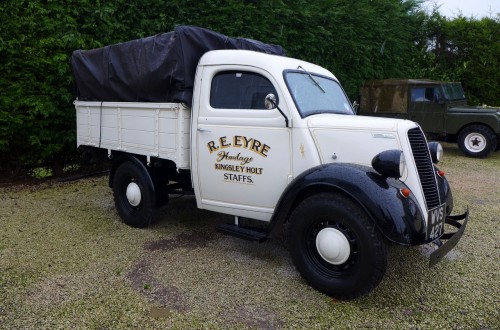
Click Here for Full Screen Image - Click Here to Download Image
 |  |  |  |  | |||||
 |  |  |  |
| Lot number | 56 |
|---|---|
| Hammer value | £5,600 |
| Description | Ford Thames E83W 10cwt Pickup |
| Registration | WVS 427 |
| Year | 1955 |
| Colour | Cream |
| Engine size | 1,172 cc |
| Chassis No. | C703951 |
| Engine No. | L9083951 |
Ford’s massive plant on the banks of the Thames at Dagenham turned raw materials into finished vehicles on a truly massive scale.
Post-war car production started with the rehashing of pre-war models, but the commercial vehicle division was soon designing a range of new British specification trucks, initially made under the Fordson brand that Henry had established for his tractor business in the 1920s (implying the involvement of his son, Edsel), but later sold under the Thames brand.
Alongside these mid-sized trucks, a range of light commercials was developed exclusive to Britain and her Empire and entirely separate from the Detroit designed V8 vehicles. These light vans and trucks were produced in huge numbers throughout the war, and continued in production almost unchanged until more modern replacements arrived in the mid-1950s.
Typical of the breed was the Ford Thames E83W 10 cwt pickup, made from 1938 to 1957, which used the ubiquitous 10hp 1,172cc side-valve unit which powered everything from cars and vans to grain elevators and saw benches. Driving through a 3-speed gearbox and heavily geared down in the rear axle, it made the E83W considerably slower than the 10hp saloons with a top speed of around 40mph but improved load-lugging ability. The ladder chassis was robust and basic with a heavy duty live-axle and cart springs.
A single vacuum-operated windscreen wiper did its best to keep the driver heading in the right direction in wet weather, while a non-adjustable seat kept him in place as he scanned the dashboard (packed with three dials!) to monitor essential engine functions. Simple, slow and sturdy, it was to be the workhorse of the British small trader well into the 1960s.
'Freda', as she is affectionately known, began life in 1955 and was lovingly restored by a previous owner in the mid-1990s. Remaining in generally good order today, she is said to run and drive well and comes with various bills for routine maintenance, several old MOTs and some technical literature relating to the model. Just oozing period charm, Freda is ready to go or show and will make a great promotional vehicle for any small business.